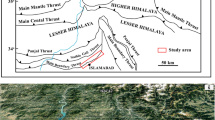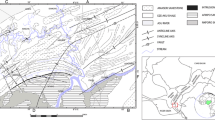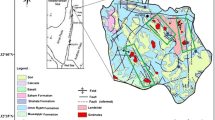Abstract
Fractures analysis carried out throughout traverses across Kalosh anticline. The anticline is located ~30 km south of Sulaimaniyah city, Kurdistan region, NE Iraq. It extends NW‒SE for ~17 km within the high folded zone of the northwestern segment of the Zagros Foreland Fold Thrust Belt. The aim of this work is for unraveling the tectonic history and detecting tectonic episodes responded for the initiation and development of the anticlinal structure. More than 450 fracture planes were classified into sets and systems according to their relations with three mutually perpendicular geometric axes (tectonic axes). Tension sets are ac and bc, the first one formed by extension along fold axis accompanying direct compression perpendicular to fold trend, whereas the second is the product of relaxation that motivated the primary compression. The shear systems are hk0, h0l and 0kl developed successively during direct compression and subsequent relaxation episodes of each tectonic force. Field observations and paleostress analysis indicate that the area was subjected to four stress phases. First is primary compressive tectonic phase in the directions NE‒SW. The second compressive tectonic stress in the direction NW–SE considered as a secondary phase. Third was extension tectonic phase in the direction NE–SW which developed during the final uplift stage of folding is normal to the major fold trend. The fourth is NW–SE extension face considerate as extension stress related to the primary NE‒SW compressive stress.







Similar content being viewed by others
REFERENCES
H. G. M. Adeeb and I. S. I. Al-Jumaily, “Mesofracture analysis of Azmur Anticline, North Eastern Iraq,” Iraqi Nat. J. Earth Sci. 10, 1–24 (2010).
I. Al-Fadhli, Y. Janardan Rao, G. Oweiss, and M. Khalil, “Polyphase deformation in apart of Zagros, Sulaimaniyah district, NE Iraq,” J. Indian Acad. Geosci. 22, 1–31 (1979).
S. H. S. Al-Hakari, “Paleostress analysis from brittle failure and minor structures in Dokan Area, Kurdistan Region, NE of Iraq,” J. Zankoy Sulaimani, Pt. A. 18, 283–310 (2017).
A. I. A. Al-Juboury, “The Upper Miocene Injana (Upper Fars) formation of Iraq: Insights on provenance history,” Arab. J. Geosci. 2, 337‒364 (2009).
S. K. Al-Shaibani, B. A. Al-Qayim, and L. Salman, “Stratigraphic analysis of Tertiary‒Cretaceous contact, Dokan area, North Iraq,” J. Geol. Soc. Iraq. 19 (2), 1–26 (1986).
B. M. Ameen, “Sequence stratigraphy of Gercus Formation (Middle Eocene) in Sulaimaniya Area, Northeastern Iraq,” Iraqi Natl. J. Earth Sci. 6 (2), 23‒32 (2006).
E. M. Anderson, The Dynamics of Faulting and Dyke Formation with Applications to Britain (Oliver & Boyd, Edinburgh, 1942).
J.-L. Blès and B. Feuga, The Fracture of Rocks (North Oxford Academic, Oxford, 1986).
T. Buday, The Regional Geology of Iraq: Stratigraphy and Paleogeography, Ed. by Dar Al-Kuttib (Univ. Mosul, Mosul, Iraq, 1980).
T. Engelder, “Analysis of pinnate joints in the Mount Desert Island granite: Implications for postintrusion kinematics in the coastal volcanic belt, Maine,” Geology 17, 564–567 (1989).
M. J. Fleuty, “The description of folds,” Proc. Geol. Assoc. 75, 461‒492 (1964).
S. F. Fouad, “Western Zagros fold–thrust belt, part II: The high folded zone,” Iraqi Bull. Geol. Min. 6, 53‒71 (2014).
P. L. Hancock and M. S. Atiya, “Tectonic significance of mesofracture systems associated with the Lebanese segment of the Dead Sea transform fault,” J. Struct. Geol. 1, 143‒153 (1979).
A. Lacazette, “Paleostress analysis from image logs using pinnate joints as slip indicators,” AAPG Bull. 93, 1489–1501 (2009).
L. B. Thompson, “Natural fracture nomenclature,” in Atlas of Borehole Imagery, No. 13 of AAPG Discovery Ser., 2nd ed (2009).
F. A. Lawa, PhD Thesis (Sulaimani, Iraq, 2004).
D. D. Pollard and A. Aydin, “Progress in understanding jointing over the past century,” Geol. Soc. Am. Bull. 100, 1181–1204 (1988).
J. G. Ramsay and M. I. Huber, The Techniques of Modern Structural Geology, Vol. 2: Folds and Fractures (Academic, London, 1987).
M. A. Taha, S. N. Al-Saadi, and I. S. Ibrahim, “Microtectonic study Dokan area NE Iraq,” Iraqi Geol. Soc. J. 28 (1), 25–35 (1995).
B. A. vand der Pluijm and S. Marshak, Earth Structure: An Introduction to Structural Geology and Tectonics, 2nd ed. (WW Norton, New York, 2004).
Dips 5.1. https://www.rocscience.com/software/dips. Accessed March 24, 2019.
Capture date September 9, 2015. https://vertex.daac. asf.alaska.edu/. Accessed November 17, 2015.
ACKNOWLEDGMENTS
We are grateful to Dr. Ahmed K. Obaid (University of Baghdad, Iraq) and Dr. Arsalan A. Othman (Iraqi Geological Survey, Iraq) for their help and consulting that improved the manuscript.
Author information
Authors and Affiliations
Corresponding author
Rights and permissions
About this article
Cite this article
Sulaiman Al-Hakari, S.H., Tokmachi, O. & Abdalla, A. Paleostress Analysis from Fractures in Kalosh Anticline, Kurdistan Region, North‒East of Iraq. Geotecton. 54, 821–831 (2020). https://doi.org/10.1134/S0016852120060035
Received:
Revised:
Accepted:
Published:
Issue Date:
DOI: https://doi.org/10.1134/S0016852120060035




